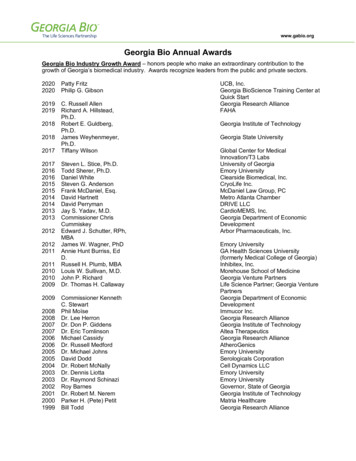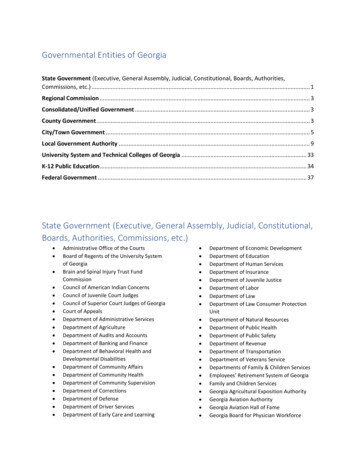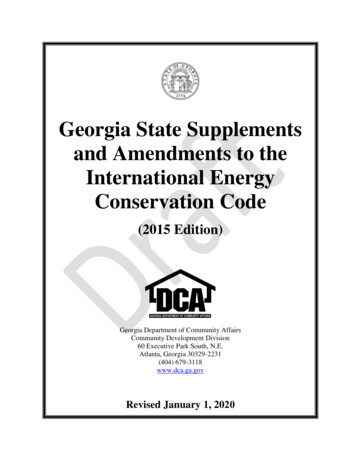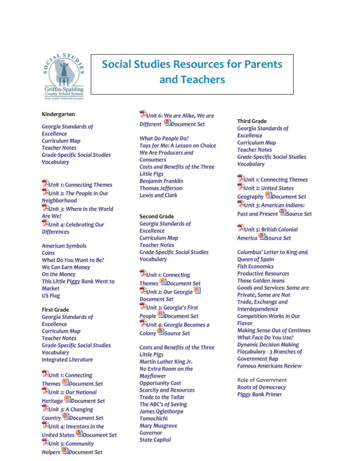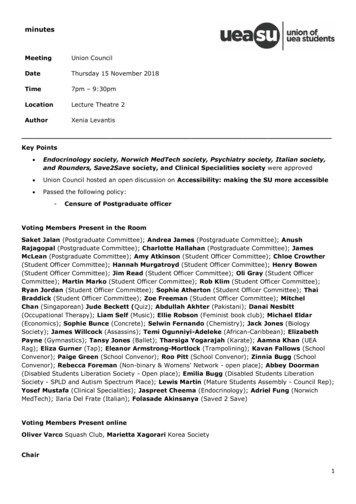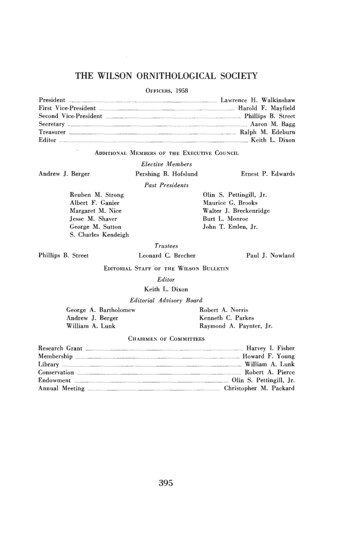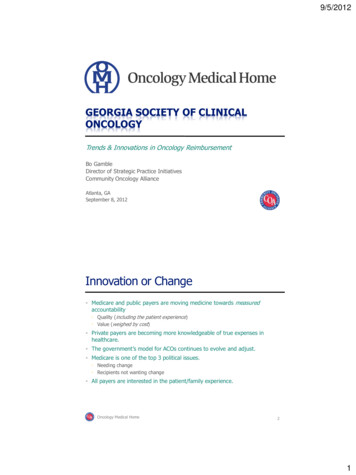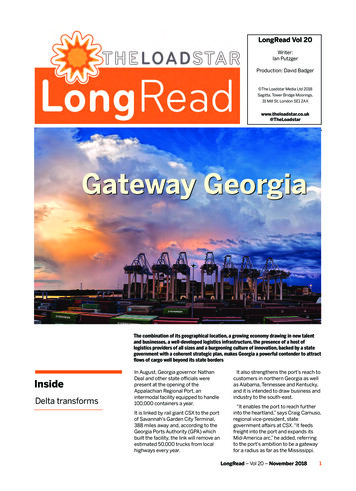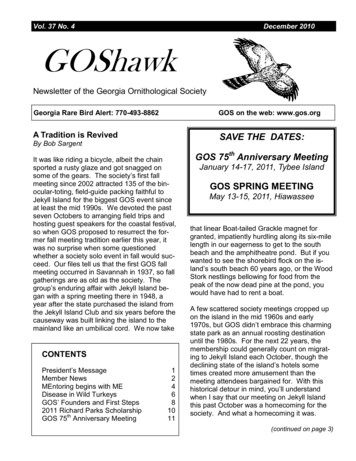
Transcription
Vol. 37 No. 4December 2010GOShawkNewsletter of the Georgia Ornithological SocietyGeorgia Rare Bird Alert: 770-493-8862GOS on the web: www.gos.orgA Tradition is RevivedSAVE THE DATES:By Bob SargentIt was like riding a bicycle, albeit the chainsported a rusty glaze and got snagged onsome of the gears. The society’s first fallmeeting since 2002 attracted 135 of the binocular-toting, field-guide packing faithful toJekyll Island for the biggest GOS event sinceat least the mid 1990s. We devoted the pastseven Octobers to arranging field trips andhosting guest speakers for the coastal festival,so when GOS proposed to resurrect the former fall meeting tradition earlier this year, itwas no surprise when some questionedwhether a society solo event in fall would succeed. Our files tell us that the first GOS fallmeeting occurred in Savannah in 1937, so fallgatherings are as old as the society. Thegroup’s enduring affair with Jekyll Island began with a spring meeting there in 1948, ayear after the state purchased the island fromthe Jekyll Island Club and six years before thecauseway was built linking the island to themainland like an umbilical cord. We now takeCONTENTSPresident’s MessageMember NewsMEntoring begins with MEDisease in Wild TurkeysGOS’ Founders and First Steps2011 Richard Parks ScholarshipGOS 75th Anniversary Meeting124681011GOS 75th Anniversary MeetingJanuary 14-17, 2011, Tybee IslandGOS SPRING MEETINGMay 13-15, 2011, Hiawasseethat linear Boat-tailed Grackle magnet forgranted, impatiently hurdling along its six-milelength in our eagerness to get to the southbeach and the amphitheatre pond. But if youwanted to see the shorebird flock on the island’s south beach 60 years ago, or the WoodStork nestlings bellowing for food from thepeak of the now dead pine at the pond, youwould have had to rent a boat.A few scattered society meetings cropped upon the island in the mid 1960s and early1970s, but GOS didn’t embrace this charmingstate park as an annual roosting destinationuntil the 1980s. For the next 22 years, themembership could generally count on migrating to Jekyll Island each October, though thedeclining state of the island’s hotels sometimes created more amusement than themeeting attendees bargained for. With thishistorical detour in mind, you’ll understandwhen I say that our meeting on Jekyll Islandthis past October was a homecoming for thesociety. And what a homecoming it was.(continued on page 3)
GOShawk—2December 2010GeorgiaOrnithologicalSocietyEXECUTIVE COMMITTEEPresident1st Vice President2nd Vice PresidentSecretaryTreasurerBusiness ManagerHistorianPast PresidentThe Oriole, Co-EditorsGOShawk, EditorGOShawk, Asst. EditorWebmasterBob SargentBill LotzDan VickersDarlene MooreJeannie WrightAshley HarringtonPhil Hardy(Vacant)Renee CarletonBob SargentJim FerrariMim EisenbergJim FlynnCommittee Chairs:Checklist & Records:Giff Beaton770-509-1482Conservation:Steve Holzman706-769-2819Earle Greene Award:John Swiderski229-242-8382Earth Share of Georgia:Mark Beebe770-435-6586Editorial:Malcolm Hodges 770-997-1968Howe Research Grant:Les Davenport678-684-3889Terrell Research Grant:Joe Meyers706-542-1882Opportunity Grants:Dan Vickers770-235-7301Avian Conservation Grants:Bob Sargent478-397-7962Membership:Patti Newell225-939-8112Cathy Ricketts404-406-9348Education:Renee Carleton706-238-5892Welcome, New Members!Fledgling MembersLisa DlugoleckiEvan BarnardStatesboro, GAAlpharetta, GABachman’s Sparrow MembersLydia KieftDr. Karen HenmanKay G. BaxterHerb WollnerCatherine KimballBowman, GAGainesville, GATownsend, GAMarietta, GAWarner Robins, GAQuail Covey MembersJoel HittLawrenceville, GARed-cockaded Woodpecker MembersPehr J. KomstadiusSavannah, GANorthern Goshawk MembersRoy BrownAlbany, GAThe 2010 GOS membership list is available electronicallyvia e-mail or as a hard copy. Please send your request tomembership@gos.org (Cathy Ricketts) for an e-mail copyor to GOS, 108 W. 8th St., Louisville, GA 30434 for a paper copy. Available to members only.Georgia Rare Bird Alert770-493-8862Jeff Sewell, CompilerGOShawk is published quarterly(March, June, September, December)Jim Ferrari, Editor444 Ashley PlaceMacon, GA ine for article submission is the 1stof the month prior to publication.Text by e-mail is appreciated.Northern Bobwhite (Colinus virginianus)
GOShawk—3December 2010A Tradition is Revived (continued from page 1)The Cornell Lab folks had reserved Little St. Simons Island for some form of feathered ritual for the weekend, so we lost the most popular destination right at the start of field trip planning. But the trips schedulewas bulging with other tantalizing destinations that spanned the entire Georgia coast, from Little TybeeIsland to Cumberland Island. As usual, the St. Catherines Island trip “sold out” instantly, much like ticketsto see a favorite rock ‘n’ roll act. Other favorites were also quickly booked, including Raccoon Key – thenew hit coastal birding destination. And speaking of “rock stars,” members clamored to go birding withJon Dunn, the meeting’s featured speaker, and the word quickly spread around the meeting hotel (Villasby the Sea) that Jon is truly the real deal – a gifted teacher, as well as a field guide guru. If you werethere and still doubted this rumored assertion, all doubts evaporated when Jon gave his “Gull Identification 101” course at the banquet. Birders are notorious for the use of jargon, so I know that more than afew of us gleefully left the banquet hall that night, because Jon had armed our mental dictionaries with atleast two new pages’ worth of ornithological tongue twisters.In addition to meeting Jon, who arrived onthe island chauffeured by Bruce Hallett,Jeannie Wright, and some of our other Atlanta-area members (I did compare him to arock star ), another highlight for me thatweekend was meeting GOS grant recipientDallas Ingram, who presented the Fridaynight program describing her research on therelationship between poultry farms and disease transmission in Wild Turkeys (see thearticle in this newsletter). I spent the finalday of the meeting co-leading a field trip toSapelo Island with Mal Hodges, one of myfavorite birding buddies and a guy who certainly doesn’t need my help. That trip wasPlain Chachalaca, from The Century Dictionary: An Encyclopedic Lexicon of the English Language, by William D. Whitneyparticularly special for me because, after(1911, The Century Co., NY).being thwarted on several previous trips toSapelo, I finally saw a chachalaca in Georgia.In fact, I saw three of them, including one bird that stood on the edge of the road 30 feet away and staredat us, as if we were the creatures who didn’t belong on the island. I have seen the species before – inTobago – where on the third consecutive day of being jolted awake by a flock (seriously) of them bellowing outside my hotel window at o’dark thirty, I was nearly moved to commit a violent act, but that’s anotherstory. What a thrill it was this time to see them one by one launching themselves from tree to tree, sort oflike winged monkeys.As always, I thank the many gracious and skilled members who led the field trips. Thank you, too, to theexecutive committee members – Bill Lotz, Jeannie Wright, Steve Holzman, Ashley Harrington, and Darlene Moore – who jumped into the trenches to organize the meeting and to handle the last-minute crush offolks registering before the evening programs. A special thank you goes to Dan Vickers for not only arranging the hotel contract and banquet, but also for being daring enough to voluntarily manage all of themeeting and trip registrations. I’ll never question your devotion to the society, Dan, but we need to talkabout your sanity.Thank you to all of the members who showed up to support GOS’ return to its former fall meeting tradition.Because your enthusiasm was convincing, we have made reservations to meet again at Villas by the Seaduring October 7-9, 2011. Come be with us again at the society’s fall home.
GOShawk—4December 2010MEntoring Begins with MEBy Phil HardyMy passion for birds and birding was born and tookflight due to the influence of two remarkable men.Neither one was my father, but as I look back on mymemories of their patient mentoring, I see how muchlike father figures they were to me. The first of thesemen was my paternal grandfather. He introduced meto birds when I was a young boy. From his breakfastroom window we could easily see his feeder. Notonly did I learn about fractions and long division fromthat breakfast room table, but he taught me aboutthe different feeder birds that came to his seedfeeder. He often smeared a big dollop of peanutbutter on the side of the feeder just for kicks. Frommy grandfather I learned about the “two Blues”:Bluebirds and Blue Jays. Bluebirds were good; BlueJays were bad. Eastern Bluebird numbers had declined due to factors such as pesticide use and secondary cavity nest competition from starlings. BlueRed-headed Woodpecker, from Royal Natural History,Jays were generally considered to be renegade ban- Volume 3, edited by Richard Lydekker (1894).dits, terrorizing other songbird nests and generallyseeming to be more of a nuisance than the beautiful, intelligent creatures they are.Growing up in the Buckhead section of Atlanta in the 1950s, I became aware of the Red-headed Woodpeckers inour Peachtree Hills neighborhood. The striking red head against a black and white back turned my head every time.Drumming on our gutters and downspouts caused me to consider if the bird knew the difference between wood andmetal. Watching the Belted Kingfisher dive for fish in Peachtree Creek was a favorite past time. The kingfisher’sloud chatter announced its presence long before I could see it flying down the creek. Since our house had no airconditioning, I slept with the window open during warm weather. Mr. Mockingbird kept me awake during manyspring nights with his seemingly never-ending repertoire. It was in that neighborhood that I discovered yellow birds.“It’s an American Goldfinch, not an escaped canary,” I was told.My grandfather’s mailbox more than once served as a nest spot for birds like the Carolina Wren. Their bulky, sideentrance nest completely blocked the mailbox, causing Grandfather to erect a temporary mail receptacle below the“nest box.” On the back porch he nailed a board, thus making a cavity from the roof and wall alignment for theHouse Wren to nest, with regularity, I might add. Whenever we saw an Eastern Bluebird on the nest box, it seemedeverything ground to a screeching halt while we gazed in reverence at such a beautiful sight. When I was about theage of ten, Grandfather took me in silence on tiptoes to a terrace planted heavily with ferns. He peeled back thelong fronds to show me the ground nest of the Eastern Towhee. That moment marked my first revelation that somebirds nested on the ground. This “field trip” was only a prelude to an unexpected trip years later.To this day, the flute-like sounds of the Wood Thrush and the trilling Pine Warbler remind me of that property and thewonderful birding knowledge Grandfather instilled in me. As a Boy Scout, it was fairly easy for me to earn the BirdWatching merit badge due to Grandfather’s lessons. Fast forward about fifty years and to the southwest part ofGeorgia, to the city of Americus. My wife and I had just bought a house in a small subdivision. It wasn’t long afterwe had moved in that a bearded and shoeless gentleman walked into the yard and said he wanted to introduce himself since we were going to be neighbors. Little did I know that this introduction would catapult me from casual birdobserver to serious birder. My neighbor was Robert Allen (Bob) Norris and, unbeknownst to me at that time, was anoted ornithologist in his day.How does a birdwatcher become a birder? There are as many stories as there are observers of the avian realm.This is how it happened to me.While sitting in a stand of mixed hardwoods and pines one beautiful April morning, I observed a Hooded Warbler pairland very close to me. Their beauty captivated me as I watched them gathering nest material. I almost forgot about
GOShawk—5December 2010the wild turkeys I was hunting. I couldn’t wait to get home and inform Dr. Norris, who told me that he had been anornithologist—a PhD from the University of California, Berkeley. And I remember he told me something about a TVantenna tower near Tallahassee and studying birds there with a man by the name of Stoddard. The name Stoddardmeant nothing to me at that time, and I certainly didn’t know anything about birds dying when they flew into communication towers. Dr. Norris assisted Herbert Stoddard for four years in his study of avian tower mortality; together,their published works provided new insights into bird species migration patterns and extreme dates.Needing a larger house, my wife, daughter, and I moved across town to a neighborhood with a twenty-five-acre lakeand a bird-friendly yard. In my workshop I built a simple hopper-type feeder and attracted Northern Cardinals,Brown-Headed Nuthatches, Red-Winged Blackbirds and House Finches. Later that fall, I observed my first WhiteIbis. The decurved bill really caught my attention, and again I was eager to tell Dr. Norris of the ibis observation.Norris often added little bits of information I knew nothing about, such as nesting habits and whether the bird wasmigratory or resident. It seemed my new birding friend knew everything I longed to know about birds. He even offered to take me on a short field trip! I was like a sponge wanting to catch the drippings of his avian knowledge.The “field trip” consisted of his driving to my new house, from which we simply walked the neighborhood and thearea behind the dam. In a ditch grown up with weeds, he pished up a Common Yellowthroat. (Pishing is man’s attempt to imitate an alarm call of a bird, thus arousing the interest and curiosity of sometimes hard-to-see species.)At the edge of planted pines he pointed out the iridescent Indigo Bunting and the skulking Yellow-Breasted Chat. Inthe woods behind the lake dam, he showed me Acadian Flycatcher, Kentucky Warbler and White-Eyed Vireo. I wassuch a neophyte, I really didn’t grasp the great importance of the Kentucky Warbler sighting and why he became sovery excited. Later, I learned that Kentucky Warblers are a secretive species fond of dense, sometimes brushyvegetation and are thus difficult to see. It would be four years until I would see another.In spite of the simplicity of that first field trip on April 6, 2002, with Dr. Norris, who was 79 years old at the time, I wascompletely hooked. I can still recall the beauty of the Cedar Waxwing’s bathing and eating privet berries only twentyfeet away from us and was amazed at Bob’s ability to pish and squeak birds into showing themselves. Later, I discovered Dr. Norris had other talents. Having grown up in South Georgia, Dr. Norris told me he put his “fowlingpiece” in a vise and bent the barrels so that the shotgun could never again claim another bird specimen. He contributed to The Life Histories of North American Birds by Arthur Cleveland Bent by writing the Green-tailed Towhee section. He was also an accomplished illustrator and artist. According to Giff Beaton, senior editor of the Georgia Ornithological Society Annotated Checklist and author of Birding Georgia, “Dr. Norris may have published more on Georgia bird life than anyone else.” In addition to his tenure at Tall Timbers Research Station, Dr. Norris taught at thecollege level. His self-taught interest in botany led to a donation of his personal herbarium to Georgia SouthwesternUniversity in Americus. Norris was curator of the herbarium until his death on September 6, 2010, at 87 years ofage. He will be greatly missed.Now that I think about it, bird watching has a lot to do with firsts. We note in our journals when we see our first of theseason Ruby-throated Hummingbird. When the first Purple Martin arrives in my back yard, we record the date. Wenote the dates of when we saw our first this or that. And we remember where we were, what the weather was like,and who we were with when we saw our first “what-ever-it-was-bird.”It’s been said that every life casts a shadow. My grandfather’s shadow was an exceedingly loving one. Dr. Norris’shadow was an inspiring and knowledgeable one. Nowadays it seems that many young people are so engrossedin the Internet or the latest electronic gadget that they suffer from NDD: Nature Deficit Disorder. The future ofmany bird species in this country is dependent on trainingtoday’s youth to become tomorrow’s nature advocates.“Towhee Bunting” by Alexander Wilson. Detailfrom print, American Ornithology (1808-1814).I will always remember the Eastern Towhee nest tuckedneatly away in the ferns at Grandfather’s house, as wellas my first field trip with my wonderful mentor, Dr. Norris.I am exceedingly fortunate to have passed through theshadow of both men and to have had Dr. Norris lead thefield trip that led to my avid interest in bird watching.
GOShawk—6December 2010Do Commercial Poultry Operations Transmit Diseases to Wild Turkeys?By Dallas R. IngramWild turkeys are susceptible to most of the same diseases that affect domestic poultry. In 2004,a commercial poultry company announced that it would be building a chicken processing plantand hatchery in Cook and Colquitt Counties in southwest Georgia. This presented a unique opportunity for research to determine if chicken farming operations pose hazards to local populations of related wild birds such as turkeys, through the transmission of diseases and parasites.The study area included counties that surrounding the new chicken operation: Turner, Ben Hill,Irwin, Worth, Tift, Berrien, Lanier, Brooks, Colquitt, Thomas, and Mitchell. From 2005 to 2008,hunter-killed and sick or dead wild turkeys were submitted to the Veterinary Diagnostic and Investigational Laboratory in Tifton, Georgia, for examination. The tissues of 64 turkeys were examined for lesions and were tested for parasites, bacteria, and viruses. The turkeys were alsotested for antibodies to pathogens such as Hemorrhagic virus, Newcastle disease virus, WestNile, Eastern equine encephalitis and St. Louis encephalitis viruses, and avian influenza.Seventy-two species of bacteria were detected in the tissues of wild turkeys, including E. coli,Pasteurella sp., and Streptococcus sp. Most of the bacteria identified in these birds are considered normal flora, but some can cause diseases. One turkey tested positive for Salmonella,while all birds were negative for Chlamydia.Fungi such as Penicillium were found in the lungsand tracheal tissues of 24 turkeys, including several species which can cause disease, especiallyin stressed or sick birds.A lesion in the brain of a hunter-killed turkey in2008 was a type that is most often associatedwith West Nile virus (WNV). We also foundnematodes or tapeworms in both the large andsmall intestines of many of the turkeys. In fact,intestinal parasites were found in 34% of thebirds. Additionally, large parasitic cysts consistentwith blood parasites were seen in the vessels ofboth the kidney and spleen of six turkeys.Using electron microscopy, we found that skin lesions from one turkey were positive for pox virus.This turkey also had a severe fungal infection thatinvaded multiple organs and an eye. Mixed infections, especially secondary fungal infections, arecommon with pox viruses.Wild Turkey, from Beauties and Wonders ofLand and Sea, by Hazlitt Alva Cuppy (1895,Mast, Crowell & Kirkpatrick).Examination of intestinal contents revealed an unknown parvo or parvo-like virus in five turkeys.These samples, along with 12 others, were sentto Dr. Zsak at the Southeast Poultry ResearchLab in Athens to test for parvovirus. One positivesample was found to be similar to a parvovirus
GOShawk—7December 2010that had recently been described from intestinalsamples of domestic chickens and turkeys.This is the first documented case of a parvovirus in wild turkey.Turkeys also were tested for various virusesthat cause encephalitis. Testing multiple organsrevealed 41 turkeys positive for WNV, including33% of the testes. Eleven turkeys tested positive for St. Louis encephalitis virus (SLE), and10 of these birds were also positive for WNV.None of the birds were positive for easternequine encephalitis (EEE), but nine of 15 werepositive for antibodies to EEE. One turkeytested positive for antibodies to avian encephalomyelitis virus (AE). This is the first documented case of antibodies to AE in a wild turkey. A turkey found dead in a peanut field in2005 was found to have Phorate in its intestine.Phorate is marketed as Thimet and Rampart,and is used to kill leaf-eating and soil insectsand mites. This is the second case of mortalityin turkeys due to Phorate poisoning documented in Georgia.Wild Turkey trap, from Florida and the Game Water-Birds, by Robert Barnwell Roosevelt (1884,Orange Judd Company, New York).Over the course of the study we did noticesome significant changes in the prevalence of some ofthe diseases and parasites, but wewere not able to directly link them to the introduction ofcommercial poultry operations. It is possible that ourfindings are natural and that, with increased diseasesurveillance and increased use of vaccines and medicated feeds within the industry, the poultry operationswill not cause significant changes in disease prevalence or variety in the wild turkey population. It is alsopossible that medicated feed present in the chickenlitter could eventually cause a reduction in the parasiteload in the wild. We realize that enough time may nothave lapsed during the course of our study to see aTapeworm, from Drittes Lesebuch, byJoseph Schäk (1874, Fr. Pustet, New York). change in the disease structure and that over timemore significant changes could occur. This study wasespecially beneficial because it is the first known health survey for wild turkeys in south Georgia,and it is the most extensive disease research effort in the southeastern United States. As such itprovides an invaluable data baseline for future research, and the results can be of use for futuremanagement of the species.
GOShawk—8December 2010Recalling GOS’ Founders and First StepsBy Bob SargentLast April I gave a presentation at an Atlanta Audubon Society (AAS) meeting about the evolution of GOS. I figured that it was a timely subject given the society’s pending 75th birthday, and itwas a great excuse for me to sift through GOS’ dusty archives. Okay, so I’m a history junkie.Have you ever wondered what GOS meetings were like in “the beginning”? Who were thehighly-educated, over-achieving people who created the society we now take for granted? Mostserious Georgia birders can parrot the names of the twentieth century’s founding fathers of professional ornithology in the state such as Eugene Murphey, Ivan Tompkins, Herb Stoddard, EarleGreene, Eugene Odum, Fred Denton, Robert Norris, and Thomas Burleigh. The contributions ofthese remarkable men (and others) have been well-documented, but let’s not overlook the instrumental works of women to the formation of GOS and to the science of ornithology in Georgia.Have you ever heard of Ethel Purcell Harris? Maybe you haven’t because the minutes fromGOS meetings during the 1930s through the 1960s usually didn’t list the first names of marriedwomen. In 1936, Ethel was the vice president of the Atlanta Bird Club, predecessor to the Atlanta Audubon Society, and she apparently was the instigator and organizer of GOS’ chartermeeting at an Atlanta restaurant (Peacock Alley) in December of that year. The society meetingminutes from that period often include a “Mrs. Hugh Harris.” I had to do some digging to figureout her first name. Ethel would become the first secretary of GOS and would later serve as editor of The Oriole. I suppose you could argue that she deserves the moniker, “Founding Motherof GOS.” Another influential woman, Mabel Rogers, attended GOS’ charter meeting and wouldbecome the society’s first female president in 1946. In fact, nearly one-third of the society’spresidents have been women. Mabel taught natural sciences, including ornithology, at what wasthen called the Georgia State College for Women – now Georgia College and State University inMilledgeville. Mabel’s passion for education is apparent in the many articles she contributed toThe Oriole in the 1940s.The society’s archives show that attendees of the first GOS meetings dressed in what we wouldconsider to be formal attire, even when they were birding. Annual dues were 1, and you couldbuy a life membership for 25. The membership consisted of a combination of professional scientists and many highly-skilled, self-trained amateurs, much like today, though there was agreater percentage of scientists (especially state and federal agency employees) involved in the1930s and 1940s than there is now. The amateur ornithologists in the early society often heldprofessional titles in their places of work; i.e., many were engineers (Tompkins), medical doctors(Murphey and Giles), and ministers (Hugh Harris). They were prolific writers of letters (gasp),and much of their correspondence pertained to the most troubling conservation issues of the day:widespread shooting of raptors, the demise of wood duck numbers caused by overhunting, lackof proper habitat management, and finding support to protect and conduct studies on wild lifesanctuaries. (Note: In those days “wildlife” was two words.) Efforts to distribute conservationnews and recruit new society members were augmented through the appointment of eight ormore regional vice presidents who represented GOS in all corners of the state, and memberswere often appointed as delegates to represent GOS at professional ornithological meetingsacross the country. Much like today, the society stressed the importance of educating youngpeople, only in those days they did so through programs in partnership with what were calledJunior Audubon Clubs.
GOShawk—9December 2010What was it like to attend a GOSmeeting in the 1930s and1940s? Forty to 60 people attended a typical meeting, and itwasn’t unusual for people whocouldn’t attend to send letters ofregret, which were read aloud toall the attendees. Consider this:the registration cost for themeeting at Vogel State Park inOctober 1939 was 3, and thatcovered the cost of meals andlodging. Meetings started onSaturday afternoons, openingwith reports given by the regional vice presidents. A shortbusiness meeting was held,which would then be followedCovers from the first two issues of The Oriole, 1936.by scientific presentations byagency professionals. The Saturday night program often featured a toastmaster who began theevening with some witty remarks, and the featured program usually included Kodak pictures ormovie reels. You’re probably wondering to yourself, “Where’s the birding?” Well, the meetingsusually concluded with one or two field trips on Sunday morning, but that was the sum total of thefield activities. In GOS’ early days, the meetings emphasized ornithology and conservation, notbirding.Reading the minutes of those meetings is a reminder of the old adage that some things neverchange. The leaders often pleaded with the membership to write letters to politicians and to become more involved in the society, members complained about the lack of youngsters in GOS,and the editor of The Oriole frequently begged for the submission of articles. The society scaledback its meeting schedule during World War II, so Eugene Odum kept the members interestedand informed by writing and mailing newsletters to them. One of his letters especially resonatedwith me in that he argued for keeping GOS ornithological, rather than allowing it to become a birdclub. Sounds like a debate we could be having today, doesn’t it? In contrast, one indication ofhow much things have changed was that of an article by Robert Norris in 1940 in which he argued that collecting birds (by shotgun) was the best means of identifying them.If you’d like to learn more about GOS and the early days of professional ornithology in Georgia, agreat place to start is the historical summary written by Eulalie Gibbs and Dick Parks for GOS’50th anniversary meeting in 1986. Dick, Branch Howe Jr., and Ken Clark updated the society’shistory summary in 1996 for the 60th anniversary meeting on Jekyll Island, and we’ll update itonce again for next month’s 75th anniversary meeting on Tybee Island. You can also buy thecomplete set of The Oriole – a treasure trove of GOS history – on DVD via the society’s businessmanager. Come join us on Tybee Island in January as we celebrate not just birds, but also theextraordinary accomplishments of the society’s founding fathers and mothers.
GOShawk—10December 2010CALLING ALL BIRDERS BETWEEN THE AGES OF 14 AND 17THE GEORGIA ORNITHOLOGICAL SOCIETYNow Accepting Applications for the2011 RICHARD PARKS SCHOLARSHIP FOR YOUNG BIRDERSYou can attend the Maine Audubon Society's"Field Ornithology and Maine Coastal Birding for Teens" Campon spectacular Hog Island, on us!Application deadline is February 18, 2011The Georgia Ornithological Society will send two teens to Maine to take part in a special camp sessionJune 19-24, 2011. Don't miss this chance to bird and explore this legendary island located in Maine's famous Muscongus Bay. Learn about seabird conservation from top ornithologists, and add puffins,murres, and other coastal birds to your life list. The GOS will cover registration fees and up to 500 reimbursement for travel expenses (scholarship recipients arrange their own travel). Food and lodging is included in the camp registration. For more information about Hog Island and the camp, visithttp://www.maineaudubon.org/explore/camp/hi overview.shtmlHow to apply: The applicant must be between the ages of 14 and 17 during the cam
group’s enduring affair with Jekyll Island be-gan with a spring meeting there in 1948, a year after the state purchased the island from the Jekyll Island Club and six years before the causeway was built linking the island to the mainland like an umbilical cor
